

List of colonial buildings and structures in Jakarta. Jayakarta around 1605–8, before its complete eradication by the Dutch, showing earlier pre-colonial structures before Batavia was founded.

Colonial buildings and structures in Jakarta include those that were constructed during the Dutch colonial period of Indonesia. S M von Rothschild. Salomon Mayer von Rothschild S M von Rothschild was a banking enterprise established in 1820 in Vienna, Austria-Hungary by Salomon Mayer Rothschild, the founder of the Rothschild banking family of Austria and a member of the Mayer Amschel Rothschild family of Frankfurt, Germany.

The business prospered, financing various Austrian government undertakings where large amounts of capital had to be raised. The bank played a major role in the building of the country's economic infrastructure including the first rail transport networks. Passed down to Salomon Mayer Rothschild's male heirs, the bank would be run by Anselm von Rothschild (President: 1848–1874), Albert Salomon von Rothschild (President: 1874–1911), and Louis Nathaniel von Rothschild (President: 1911-1939).
Kristallnacht. ( German pronunciation: [kʁɪsˈtalˌnaχt] ), . Also referred to as the , or [ˌʁaɪçs.kʁɪsˈtalˌnaχt], [poˈgʁoːmˌnaχt], and [noˈvɛmbɐ.poˌgʁoːmə], was a pogrom (a series of coordinated attacks) against Jews throughout Nazi Germany and parts of Austria on 9–10 November 1938, carried out by SA paramilitary and civilians. The Holocaust. The Mass Psychology of Fascism. Gestalt therapy. Gestalt therapy is an existential/experiential form of psychotherapy that emphasizes personal responsibility, and that focuses upon the individual's experience in the present moment, the therapist-client relationship, the environmental and social contexts of a person's life, and the self-regulating adjustments people make as a result of their overall situation.
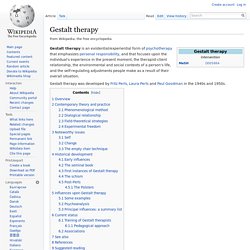
§Overview[edit] Edwin Nevis described Gestalt therapy as "a conceptual and methodological base from which helping professionals can craft their practice".[1] In the same volume Joel Latner stated that Gestalt therapy is built upon two central ideas: that the most helpful focus of psychotherapy is the experiential present moment, and that everyone is caught in webs of relationships; thus, it is only possible to know ourselves against the background of our relationship to the other.[2] The historical development of Gestalt therapy (described below) discloses the influences that generated these two ideas.
Wildcat strike action. A wildcat strike action, often referred to as a wildcat strike, is a strike action undertaken by unionized workers without union leadership's authorization, support, or approval; this is sometimes termed, an unofficial industrial action.
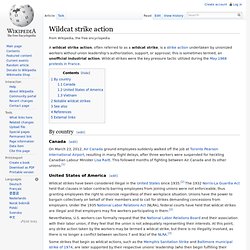
Wildcat strikes were the key pressure tactic utilized during the May 1968 protests in France. Theresienstadt concentration camp. Coordinates : 50°30′48″N 14°10′1″E / 50.51333°N 14.16694°E / 50.51333; 14.16694 The (2005) , also referred to as Theresienstadt Ghetto, [ 1 ] [ 2 ] [ 3 ] was established by the SS during World War II in the fortress and garrison city of Terezín (German name ), located in what is now the Czech Republic. During World War II it served as a Nazi concentration camp staffed in equal numbers by German Nazi guards and their ethnic Czech collaborators.
Tens of thousands of Jews were murdered there and over 150,000 others (including tens of thousands of children) were held there for months or years, before then being sent to their deaths on rail transports to Treblinka and Auschwitz extermination camps in Poland, as well as to smaller camps elsewhere. Auschwitz concentration camp. Auschwitz concentration camp (German: Konzentrationslager Auschwitz [ˈʔaʊ̯ʃvɪt͡s] ( )) was a network of concentration and extermination camps built and operated by the Third Reich in Polish areas annexed by Nazi Germany during World War II.
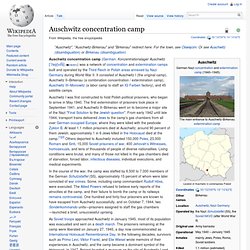
It consisted of Auschwitz I (the original camp), Auschwitz II–Birkenau (a combination concentration / extermination camp), Auschwitz III–Monowitz (a labor camp to staff an IG Farben factory), and 45 satellite camps. Auschwitz I was first constructed to hold Polish political prisoners, who began to arrive in May 1940. Dachau concentration camp. Dachau concentration camp (German: Konzentrationslager (KZ) Dachau, IPA: [ˈdaxaʊ]) was the first of the Nazi concentration camps opened in Germany, intended to hold political prisoners.
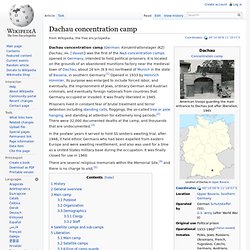
It is located on the grounds of an abandoned munitions factory near the medieval town of Dachau, about 16 km (9.9 mi) northwest of Munich in the state of Bavaria, in southern Germany.[1] Opened in 1933 by Heinrich Himmler, its purpose was enlarged to include forced labor, and eventually, the imprisonment of Jews, ordinary German and Austrian criminals, and eventually foreign nationals from countries that Germany occupied or invaded. It was finally liberated in 1945. Prisoners lived in constant fear of brutal treatment and terror detention including standing cells, floggings, the so-called tree or pole hanging, and standing at attention for extremely long periods.[2] There were 32,000 documented deaths at the camp, and thousands that are undocumented.[3] Internment. "Interned" redirects here.
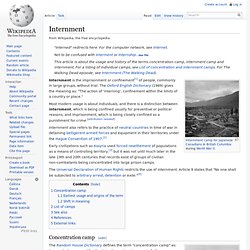
For the computer network, see Internet. Internment is the imprisonment or confinement[1] of people, commonly in large groups, without trial. The Oxford English Dictionary (1989) gives the meaning as: "The action of 'interning'; confinement within the limits of a country or place. " Most modern usage is about individuals, and there is a distinction between internment, which is being confined usually for preventive or political reasons, and imprisonment, which is being closely confined as a punishment for crime. Bełżec extermination camp. Between 430,000 and 500,000 Jews are believed to have been murdered by German Nazis at Bełżec, along with an unknown number of Poles and Romani people.[4][6] Only seven Jews imprisoned at the camp have survived World War II;[5] only one,[7] or two known from their submitted testimonies.[8] The small number of Holocaust survivors who could testify about it is the primary reason why this camp is so little known despite the enormous number of victims.[8] Belzec mausoleum.
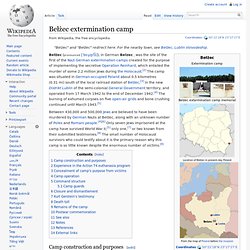
The field of crushed stone serves as one flat grave marker, because the entire perimeter contains human ashes mixed with sand.[9] Rails in Belzec. Bergen-Belsen concentration camp. Action T4. Reich Leader Bouhler and Dr. med.
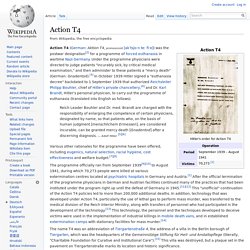
Brandt are charged with the responsibility of enlarging the competence of certain physicians, designated by name, so that patients who, on the basis of human judgment [menschlichem Ermessen], are considered incurable, can be granted mercy death [Gnadentod] after a discerning diagnosis. — Adolf Hitler [5][6] Various other rationales for the programme have been offered, including eugenics, natural selection, racial hygiene, cost effectiveness and welfare budget.[7][8] Language[edit] Euthanasia (from Greek: εὐθανασία; "good death": εὖ, eu; "well" or "good" – θάνατος, thanatos; "death") refers to the practice of intentionally ending a life in order to relieve pain and suffering.[16] Hitler's directive to create the programme used the German term "Gnadentod" which translates to merciful death.[5][6] Nazi concentration camps. Nazi Germany maintained concentration camps (German: Konzentrationslager, or KZ) throughout the territories it controlled.

The term was borrowed from the British concentration camps of the Second Anglo-Boer War. The first Nazi concentration camps were erected in Germany in March 1933 immediately after Hitler became Chancellor and his NSDAP was given control over the police through Reich Interior Minister Wilhelm Frick and Prussian Acting Interior Minister Hermann Göring. Used to hold and torture political opponents and union organizers, the camps initially held around 45,000 prisoners.
Heinrich Himmler's SS took full control of the police and concentration camps throughout Germany in 1934–35. Vivienne Westwood. Dame Vivienne Westwood, DBE, RDI (born Vivienne Isabel Swire on 8 April 1941) is an English fashion designer and businesswoman, largely responsible for bringing modern punk and new wave fashions into the mainstream.[1] Westwood came to public notice when she made clothes for Malcolm McLaren's boutique in the King's Road, which became famous as "SEX". It was their ability to synthesise clothing and music that shaped the 1970s UK punk scene, dominated by McLaren's band, the Sex Pistols. She was deeply inspired by the shock-value of punk - "seeing if one could put a spoke in the system". Life and career[edit] Kim Beazley. This article is about the former Australian Labor Party Leader. Edmund Dudley. Edmund Dudley (c. 1462[1] or 1471/1472[2] – 17 August 1510) was an English administrator and a financial agent of King Henry VII.
Thomas Moore. Early life[edit] Thomas Moore was born at 12 Aungier-street in Dublin, Ireland, on 28 May 1779.[1] over his father's grocery shop, his father being from the Kerry Gaeltacht and his mother, Anastasia Codd, from Wexford. He had two younger sisters, Kate and Ellen. Battle of Bir Hakeim. Hughenden Manor.
Imperial Tobacco. Imperial Tobacco is listed on the London Stock Exchange and is a constituent of the FTSE 100 Index. It had a market capitalisation of approximately £24.3 billion as of 23 December 2011, the 19th-largest of any company with a primary listing on the London Stock Exchange.[5] History[edit] 1901 to 2000[edit] 2 ounces (57 g) tin for J&F Bell "Three Nuns" tobacco The Imperial Tobacco Company was created in 1901 through the amalgamation of thirteen British tobacco and cigarette companies: W.D.
& H.O. Lebanon.